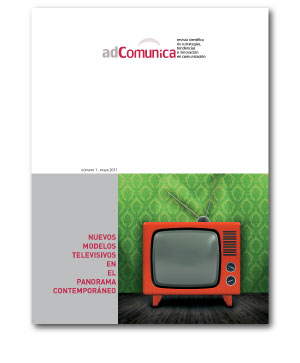Las estrategias publicitarias de las marcas en el contexto de crisis
Contenido principal del artículo
Resumen
La crisis económica ha evidenciado una situación que venía aconteciendo en la comunicación estratégica desde hace años: el debilitamiento del modelo publicitario establecido. Las organizaciones se enfrentan a una pérdida progresiva de la eficacia comunicativa de la publicidad; a la dificultad de conectar emocionalmente con sus consumidores; al retroceso de los medios convencionales; a la explosión de la era de las relaciones personales y a la hegemonía de un ciudadano, proactivo y crítico, que replantea el propio concepto de comunicación. Todo este contexto hace que las empresas y organizaciones redefinan sus estrategias publicitarias, modificando objetivos, públicos, valores, lenguajes, medios y modos de contactar con sus públicos.
El objetivo de este artículo es el estudio de las principales opciones estratégicas publicitarias que están desarrollando las organizaciones para sus marcas en el actual contexto de crisis. Para ello, se aborda el análisis de la estrategia publicitaria de una muestra significativa de los principales anunciantes del panorama nacional, representando a diferentes sectores de consumo. Mediante el análisis de contenido, combinado con análisis del discurso de las estrategias publicitarias de las principales marcas, procedemos al establecimiento de variables de análisis y a la categorización de los objetivos, estrategias, acciones y construcciones discursivas que las marcas desarrollan en sus políticas de comunicación.
Los resultados de la investigación permiten concluir que las marcas están apostando por cuatro principales tipos de estrategias publicitarias: la estrategia de construcción de las U-brands, la defensa del valor de la marca tradicional, la estrategia centrada en el precio como principal argumento y la estrategia ofensiva de las marcas de distribuidor en torno a la calidad.
Descargas
Detalles del artículo
1. Política propuesta para Revistas que ofrecen Acceso Abierto
Los autores que publican en esta revista están de acuerdo con los siguientes términos:
- Los autores conservan los derechos de autor y garantizan a la revista el derecho de ser la primera publicación del trabajo al igual que licenciado bajo la licencia CC BY-SA, que permite a otros compartir el trabajo con un reconocimiento de la autoría del trabajo y la publicación inicial en esta revista.
- Los autores pueden establecer por separado acuerdos adicionales para la distribución no exclusiva de la versión de la obra publicada en la revista (por ejemplo, situarlo en un repositorio institucional o publicarlo en un libro), con un reconocimiento de su publicación inicial en esta revista.


